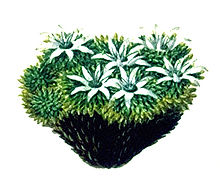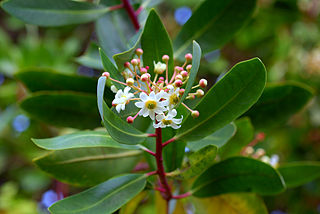
Drimys is a genus of about eight species of woody evergreen flowering plants, in the family Winteraceae. The species are native to the Neotropics, ranging from southern Mexico to the southern tip of South America. They are primitive dicots, associated with the humid temperate Antarctic flora of the Southern Hemisphere, which evolved millions of years ago on the ancient supercontinent of Gondwana. Members of the family generally have aromatic bark and leaves, and some are used to extract essential oils.

Griselinia is a genus of seven species of shrubs and trees, with a highly disjunct distribution native to New Zealand and South America. It is a classic example of the Antarctic flora. It is the sole genus in the family Griseliniaceae; in the past it was often placed in Cornaceae but differs from that in many features.
Bolster heath or cushion moorland is a type of vegetation community that features a patchwork of very low growing, tightly packed plants found at the limits of some alpine environments. The cushion plants form a smooth surfaced 'cushions' from several different plants, hence the common name of cushion heath. The cushion growth habit provides protection against the desiccating wind and help keep the cluster warm.

The Chonos Archipelago is a series of low, mountainous, elongated islands with deep bays, traces of a submerged Chilean Coast Range. Most of the islands are forested with little or no human settlement. The deep Moraleda Channel separates the islands of the Chonos Archipelago from the mainland of Chile and from Magdalena Island.
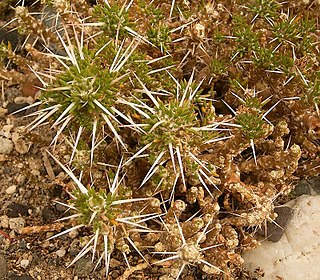
Maihuenia is a genus of cactus and the sole genus of the subfamily Maihuenioideae, which is the smallest subfamily of the Cactaceae. The genus comprises two cushion-forming, mucilaginous species. They are found at high elevation habitats of Andean Argentina and Chile.

Abrotanella is a genus in the family Asteraceae, of 23 species, native to Australia, New Zealand and southern South America.

Dracophyllum is a genus of plants belonging to the family Ericaceae, formerly Epacridaceae. There are 61 species in the genus, mostly shrubs, but also cushion plants and trees, found in New Zealand, Australia, Lord Howe Island and New Caledonia. The name Dracophyllum, meaning dragon-leaf, refers to their strong outward similarity to the unrelated Dracaena, sometimes known as dragon tree. Although dicotyledonous, they resemble primitive monocots with their slender leaves concentrated in clumps at the ends of the branches; they are sometimes called grass-trees.
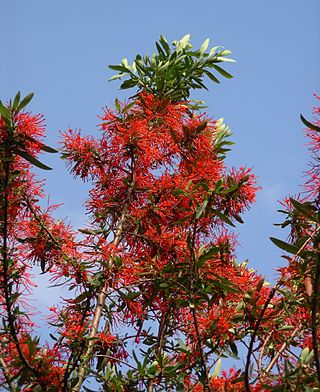
Embothrium is a genus of two to eight species in the plant family Proteaceae, native to southern South America, in Chile and adjacent western Argentina; the genus occurs as far south as Tierra del Fuego. Common names include Chilean firebush in English, notro in Argentina, ciruelillo, fosforito or notro chileno in Chilean Spanish.

The family Stylidiaceae is a taxon of dicotyledonous flowering plants. It consists of five genera with over 240 species, most of which are endemic to Australia and New Zealand. Members of Stylidiaceae are typically grass-like herbs or small shrubs and can be perennials or annuals. Most species are free standing or self-supporting, though a few can be climbing or scrambling.

Ripogonum is a genus of flowering plants confined to eastern Australia, New Zealand, and New Guinea. Until recently this genus was included in the family Smilacaceae, and earlier in the family Liliaceae, but it has now been separated as its own family Ripogonaceae.

As with other flowering plants, the taxonomy of Banksia has traditionally been based on anatomical and morphological properties of the Banksia flower, fruiting structure and seed, along with secondary characteristics such as leaf structure and growth habit. Increasingly, molecular evidence from DNA is providing important new insights into relationships within the genus and between this and other genera in the Proteaceae.

Donatia is a genus of two cushion plant species in the family Stylidiaceae. The name commemorates Vitaliano Donati, an Italian botanist.
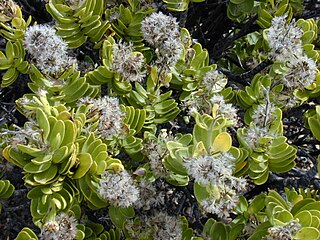
Dubautia is a genus of flowering plant in the family Asteraceae. The genus was named after Joseph Eugène DuBaut (1796-1832), an officer in the French Navy who participated in Freycinet's expedition.

A cushion plant is a compact, low-growing, mat-forming plant that is found in alpine, subalpine, arctic, or subarctic environments around the world. The term "cushion" is usually applied to woody plants that grow as spreading mats, are limited in height above the ground, have relatively large and deep tap roots, and have life histories adapted to slow growth in a nutrient-poor environment with delayed reproductivity and reproductive cycle adaptations. The plant form is an example of parallel or convergent evolution with species from many different plant families on different continents converging on the same evolutionary adaptations to endure the harsh environmental conditions.

Donatia novae-zelandiae is a species of cushion plant in the family Donatiaceae and is closely related to species in the family Stylidiaceae. It is found in the alpine and subalpine regions of New Zealand and Tasmania. Donatia novae-zelandiae has free stamens and petals, paracytic stomata, and a pollen morphology distinct from the genera of the sister family Stylidiaceae. It was first described by Joseph Dalton Hooker in 1853 and published in his Flora Novae-Zelandiae.
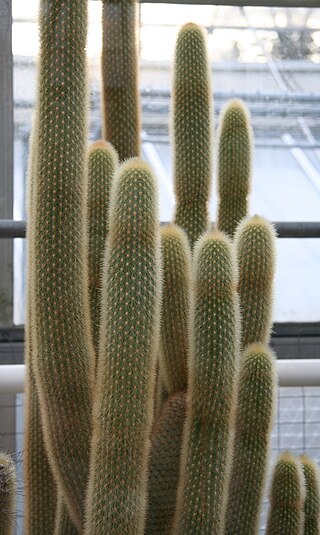
Haageocereus fascicularis commonly known as 'Quisco de la precordillera de Arica' is a species of cactus from the family Cactaceae. It is endemic to southern Peru and northern Chile.

Chiliotrichum is a genus of flowering plants in the family Asteraceae.
Trachelostenus is a genus of beetles belonging to Tenebrionoidea. It is native to the Valdivian forests of Chile, and has at least two species, T. inaequalis (Solier) and T. fascicularis (Philipp). It was historically considered the only member of the family Trachelostenidae, but a 2015 study sunk the genus into the tenebrionid subfamily Tenebrioninae.
Astelia pumila is a species of flowering plant in the recently named family Asteliaceae. It is an evergreen silver-green perennial from western Patagonia in southern Chile and nearby areas of Argentina. It grows in forests as well as wetlands. The plant is, together with Donatia fascicularis, dominant in the cushion bogs that exists in areas exposed to the Pacific coast. As such it does not usually found together with Sphagnum which tend to grow slightly more inland. Localities where the plant is found include, from north to south; Queulat National Park, Chonos Archipelago, Taitao Peninsula, San Rafael Lake, the vicinities of Caleta Tortel and Tierra del Fuego National Park.
Jansonius is a genus of leaf beetles in the subfamily Eumolpinae. It is found in Chile and Argentina. It was formerly placed in the tribe Adoxini, section Myochroites, but is now placed in Nodinini, section Metachromites.
